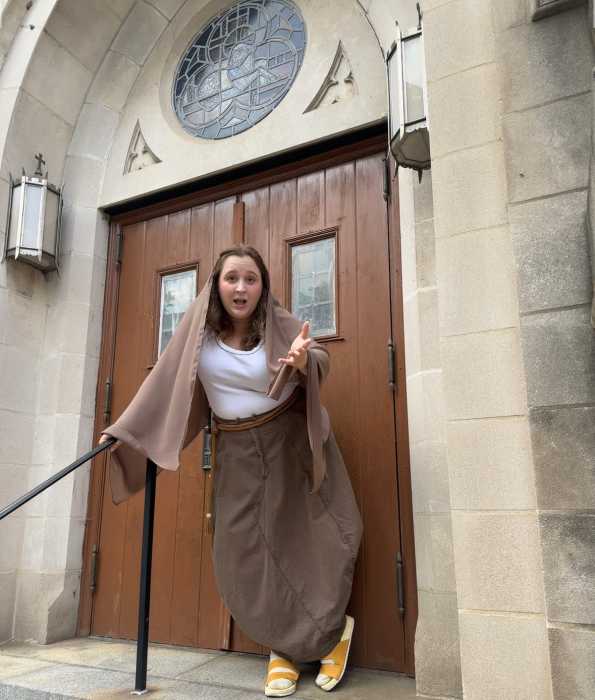Pierre-Yves Cardinal as Francis and Xavier Dolan as Tom in “Tom at the Farm.” | CLARA PALARDY
BY GARY M. KRAMER | Gay Canadian filmmaker Xavier Dolan’s fourth film, “Tom at the Farm,” was made in 2013, but it is getting a belated release now. While fans of the director’s work (or completists) may feel compelled to see this pretentious thriller about Tom (Dolan), a gay man visiting his late boyfriend’s family, most viewers should steer clear. “Tom at the Farm” is a frustrating experience.
The film, based on a play by Michael Marc Bouchard, who co-wrote the script with Dolan, is heavy-handed. Dolan cannot resist seemingly ominous symbols like dead cows, creating pregnant pauses that should be freighted with meaning (but are not), and introducing an ear-splitting orchestral score by Gabriel Yared that insists on telling viewers what to feel. To its credit, the music generates more in the way of emotion than the acting or plot. Most of “Tom at the Farm” is unsatisfying.
At the start of the film, Tom, whose unruly dyed-blond hair visually expresses his despair, arrives at his lover Guillaume’s family farm. No one is home, so he enters the house, only to fall asleep at the kitchen table. Guillaume’s mother, Agathe (Lise Roy), soon discovers him and accepts Tom, unaware of his relationship to her son. She is more surprised and annoyed that Guillaume’s girlfriend Sarah (Evelyne Brochu) has not come for the funeral. Agathe mentions her other son, Francis (Pierre-Yves Cardinal), in conversation, which surprises Tom.
Francis surprises the sleeping Tom later that night, telling him that he best not disclose Guillaume’s homosexuality to his mother. Francis threatens Tom repeatedly the next day: warning Tom while he is in the shower, slapping him around in the men’s room at the church after the service, and chasing him and physically attacking Tom in a cornfield on the farm. While Tom wants to leave — and even tries to — he foolishly returns to the farm for more punishment. (Viewers are free to go, and should).
Eventually Tom enters into a queer Stockholm syndrome kind of relationship with Francis. After Francis forces Tom to do some coke, the men start dancing together. Another scene has Francis, who previously choked Tom to scare him, choking Tom for sexual gratification.
“Tom at the Farm” is full of such conundrums, which is why it is so frustrating. The characters are complete ciphers, and no amount of overacting, or confessional speeches illuminate why Tom and Francis (and to some extent Agathe) behave the way they do.
There is no indication how long Tom and Guillaume were together, which may not be important, but Tom’s grief over his dead boyfriend is never felt. Too much of Dolan’s performance has Tom accepting the strange goings on at the farm and trying to navigate a relationship with Francis. The mercurial Francis — the film’s most interesting character — becomes involved with Tom for reasons that are ambiguous. But the character is underdeveloped to the point where viewers will not care if Tom succumbs to his clutches or escapes. Cardinal’s performance alternates between creepy and campy.
Perhaps the biggest problem with the film is that Dolan never effectively ratchets up the tension. Tom frantically packs his bags to leave the farm. The music swells. He steps outside, free, perhaps…and then…nothing. Scenes of Francis menacing Tom play up the homoeroticism, which dilutes the sinister power. The film’s abrupt, nonsensical ending is head scratching.
About an hour in to “Tom at the Farm,” Sarah is summoned to the farm, and the film gets moderately interesting. Her arrival disturbs Francis and shows that Tom has some power over him. But as Sarah lies to Agathe and speaks some truths to Tom, the film spirals off to another scene, which takes place in a bar, where Tom learns something critical.
The bar scene is well shot, and Dolan does show some visual flair here, but too often he employs cinematic tricks to impress audiences, such as shooting scenes in slow-motion, or featuring some long tracking shots of the countryside to emphasize the isolation. There are also countless close-ups of Dolan, so many that one could have quite a drinking game.
If only the actor’s performance was as strong as his confidence. It is difficult to feel anything (even with the ominous music) for Tom because he behaves irrationally. Dolan never provides any insight into his character. If Tom is a blank slate, reacting to the strange, grieving characters he meets, why does he embrace their brand of crazy? When Sarah tries to get him to be rational, he resists for no convincing reason.
Ultimately, “Tom at the Farm” fails to engage visually, emotionally, or dramatically.
































